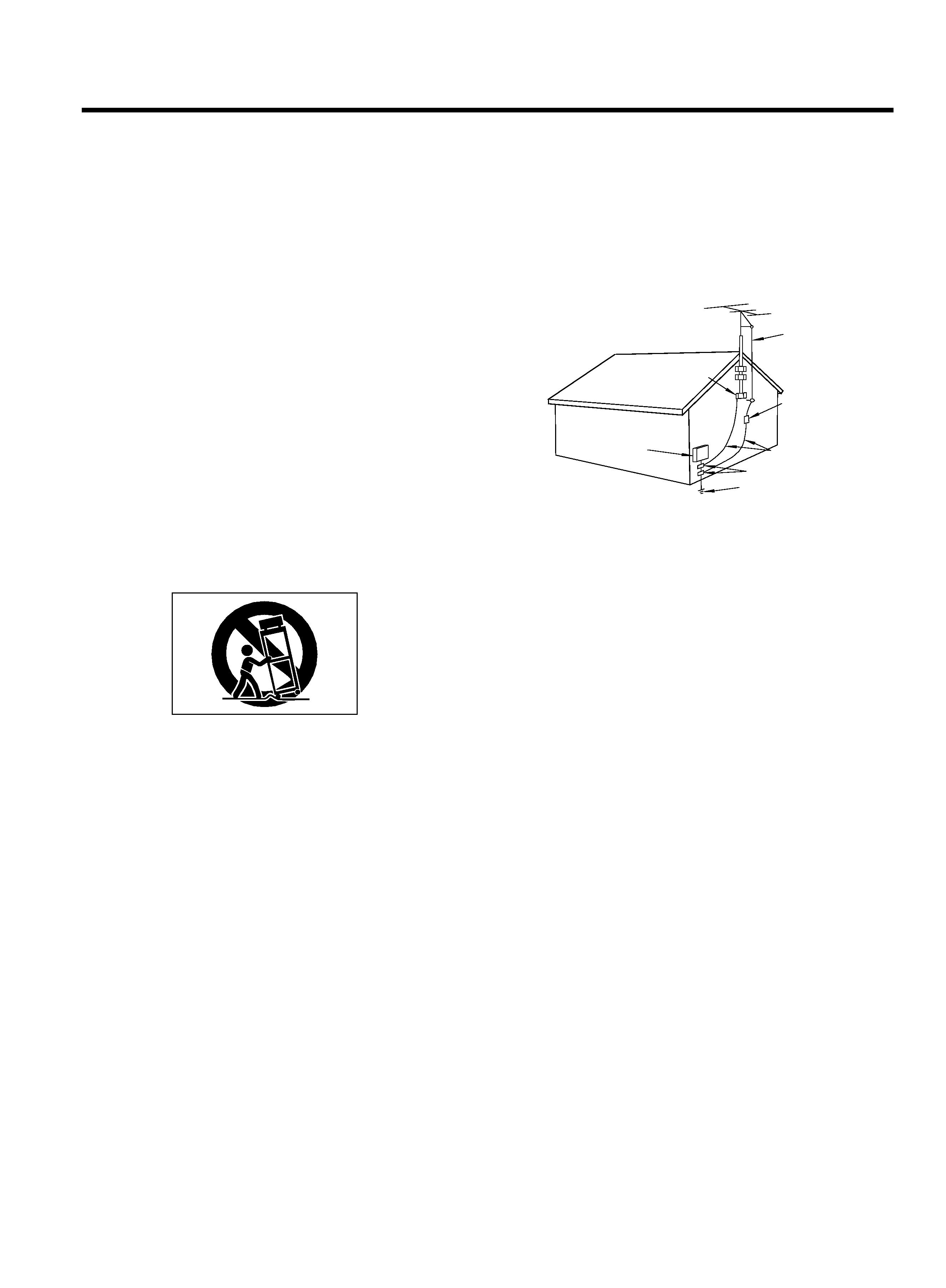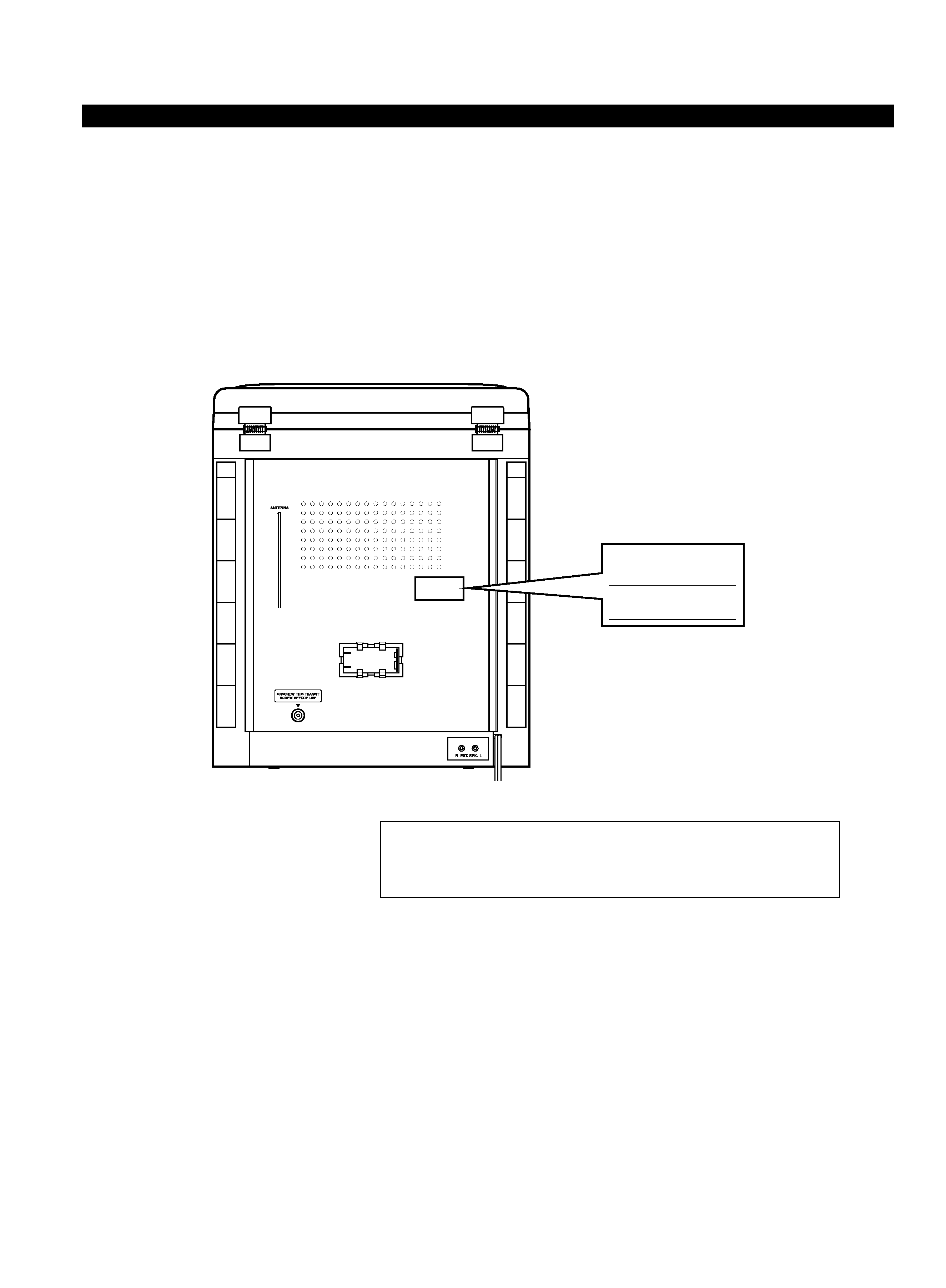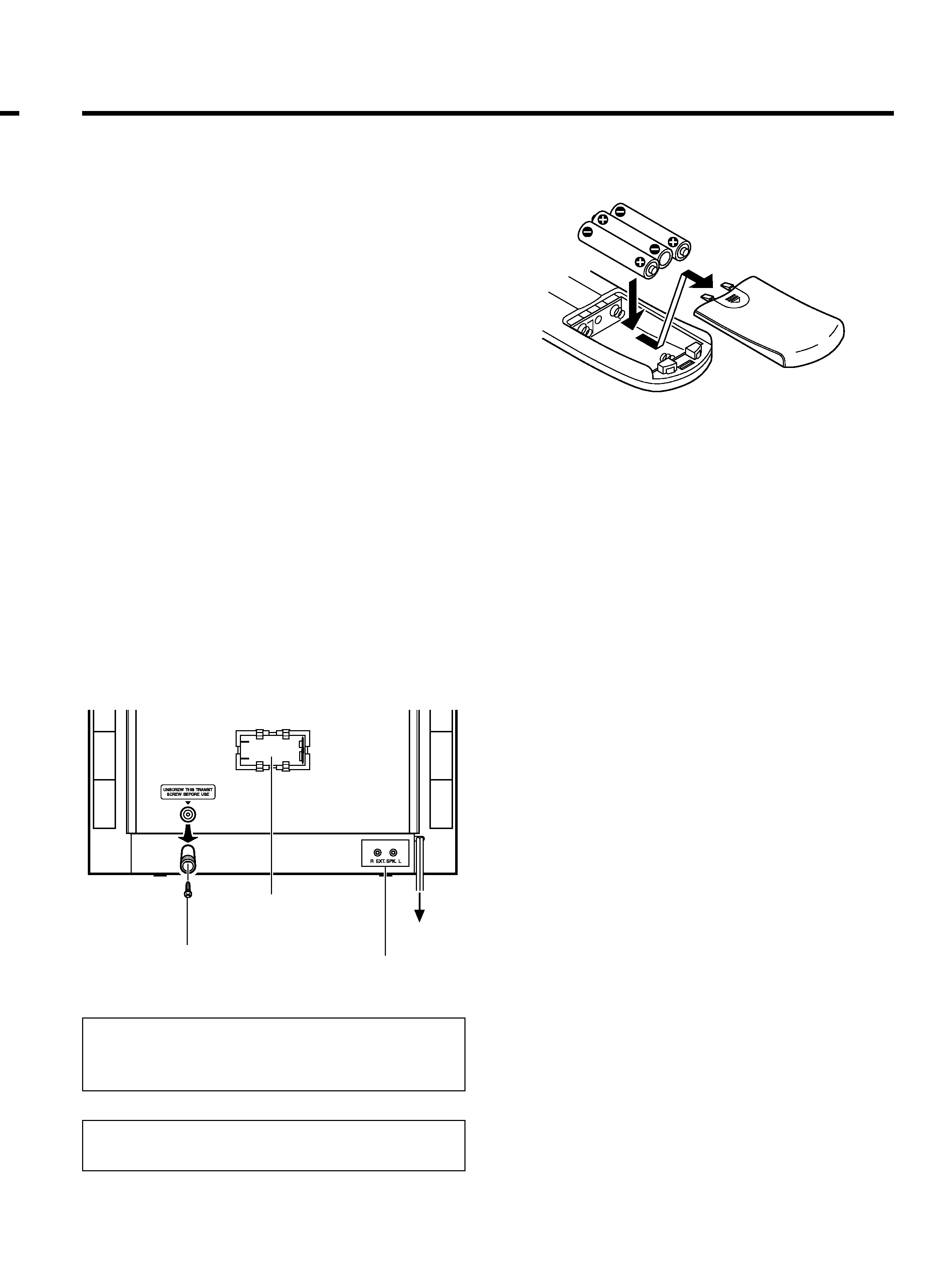
The lightning flash with arrowhead symbol, within an equilateral triangle, is intended to alert
the user to the presence of uninsulated "dangerous voltage" within the product's enclosure
that may be of sufficient magnitude to constitute a risk of electric shock to persons.
dc-d2700
Û
Thanks for buying a TEAC. Read this manual carefully to get the best performance from this unit.
Digital Compact Hi-Fi System
OWNER'S MANUAL
9A06831900
This appliance has a serial number located
on the rear panel. Please record the model
number and serial number and retain them
for your records.
Model number
Serial number
WARNING: TO PREVENT FIRE OR SHOCK
HAZARD, DO NOT EXPOSE THIS
APPLIANCE TO RAIN OR MOISTURE.
The exclamation point within an equilateral triangle is intended to alert the user to the
presence of important operating and maintenance (servicing) instructions in the
literature accompanying the appliance.
CAUTION: TO REDUCE THE RISK OF ELECTRIC SHOCK, DO NOT REMOVE
COVER (OR BACK). NO USER-SERVICEABLE PARTS INSIDE. REFER
SERVICING TO QUALIFIED SERVICE PERSONNEL.
Ü
ÿ
Y

- 2 -
IMPORTANT SAFETY INSTRUCTIONS
CAUTION:
· Read all of these Instructions.
· Save these Instructions for later use.
· Follow all Warnings and Instructions marked on the audio
equipment.
1) Read Instructions -- All the safety and operating instructions
should be read before the product is operated.
2) Retain Instructions -- The safety and operating instructions
should be retained for future reference.
3) Heed Warnings -- All warnings on the product and in the oper-
ating instructions should be adhered to.
4) Follow Instructions -- All operating and use instructions should
be followed.
5) Cleaning -- Unplug this product from the wall outlet before
cleaning. Do not use liquid cleaners or aerosol cleaners. Use a damp
cloth for cleaning.
6) Attachments -- Do not use attachments not recommended by
the product manufacturer as they may cause hazards.
7) Water and Moisture -- Do not use this product near water _ for
example, near a bath tub, wash bowl, kitchen sink, or laundry tub; in
a wet basement; or near a swimming pool; and the like.
8) Accessories -- Do not place this product on an unstable cart,
stand, tripod, bracket, or table. The product may fall, causing serious
injury to a child or adult, and serious damage to the product. Use
only with a cart, stand, tripod, bracket, or table recommended by the
manufacturer, or sold with the product. Any mounting of the product
should follow the manufacturer's instructions, and should use a
mounting accessory recommended by the manufacturer.
9) A product and cart combination should be moved with care. Quick
stops, excessive force, and uneven surfaces may cause the product
and cart combination to overturn.
"Note to CATV system installer:
This reminder is provided to call the CATV system installer's atten-
tion to Section 820-40 of the NEC which provides guidelines for
proper grounding and, in particular, specifies that the cable ground
shall be connected to the grounding system of the building, as close
to the point of cable entry as practical."
ANTENNA
LEAD IN
WIRE
ANTENNA
DISCHARGE UNIT
(NEC SECTION 810-20)
G
ROUNDING CONDUCTORS
(NEC SECTION 810-21)
GROUND CLAMPS
POWER SERVICE GROUNDING
ELECTRODE SYSTEM
(NEC ART 250. PART H)
NEC - NATIONAL ELECTRICAL CODE
ELECTRIC
SERVICE
EQUIPMENT
Example of Antenna Grounding as per
National Electrical Code, ANSI/NFPA 70
GROUND
CLAMP
15) Lightning -- For added protection for this product during a light-
ning storm, or when it is left unattended and unused for long periods
of time, unplug it from the wall outlet and disconnect the antenna or
cable system. This will prevent damage to the product due to light-
ning and power-line surges.
16) Power Lines -- An outside antenna system should not be locat-
ed in the vicinity of overhead power lines or other electric light or
power circuits, or where it can fall into such power lines or circuits.
When installing an outside antenna system, extreme care should be
taken to keep from touching such power lines or circuits as contact
with them might be fatal.
17) Overloading -- Do not overload wall outlets, extension cords, or
integral convenience receptacles as this can result in risk of fire or
electric shock.
18) Object and Liquid Entry -- Never push objects of any kind into
this product through openings as they may touch dangerous voltage
points or short-out parts that could result in a fire or electric shock.
Never spill liquid of any kind on the product.
19) Servicing -- Do not attempt to service this product yourself as
opening or removing covers may expose you to dangerous voltage
or other hazards. Refer all servicing to qualified service personnel.
20) Damage Requiring Service -- Unplug this product from the
wall outlet and refer servicing to qualified service personnel under
the following conditions:
a) when the power-supply cord or plug is damaged.
b) if liquid has been spilled, or objects have fallen into the product.
c) if the product has been exposed to rain or water.
d) if the product does not operate normally by following the operat-
ing instructions. Adjust only those controls that are covered by the
operating instructions as an improper adjustment of other controls
may result in damage and will often require extensive work by a qual-
ified technician to restore the product to its normal operation.
e) if the product has been dropped or damaged in any way.
f ) when the product exhibits a distinct change in performance _ this
indicates a need for service.
21) Replacement Parts -- When replacement parts are required,
be sure the service technician has used replacement parts specified
by the manufacturer or have the same characteristics as the original
part. Unauthorized substitutions may result in fire, electric shock, or
other hazards.
22) Safety Check -- Upon completion of any service or repairs to
this product, ask the service technician to perform safety checks to
determine that the product is in proper operating condition.
23) Wall or Ceiling Mounting -- The product should be mounted to
a wall or ceiling only as recommended by the manufacturer.
24) Heat -- The product should be situated away from heat sources
such as radiators, heat registers, stoves, or other products (includ-
ing amplifiers) that produce heat.
10) Ventilation -- Slots and openings in the cabinet are provided for
ventilation and to ensure reliable operation of the product and to pro-
tect it from overheating, and these openings must not be blocked or
covered. The openings should never be blocked by placing the prod-
uct on a bed, sofa, rug, or other similar surface. This product should
not be placed in a built-in installation such as a bookcase or rack
unless proper ventilation is provided or the manufacturer's instruc-
tions have been adhered to.
11) Power Sources -- This product should be operated only from
the type of power source indicated on the marking label. If you are
not sure of the type of power supply to your home, consult your prod-
uct dealer or local power company. For products intended to operate
from battery power, or other sources, refer to the operating instruc-
tions.
12) Grounding or Polarization -- This product may be equipped
with a polarized alternating-current line plug (a plug having one
blade wider than the other). This plug will fit into the power outlet
only one way. This is a safety feature. If you are unable to insert the
plug fully into the outlet, try reversing the plug. If the plug should still
fail to fit, contact your electrician to replace your obsolete outlet. Do
not defeat the safety purpose of the polarized plug.
13) Power-Cord Protection -- Power-supply cords should be rout-
ed so that they are not likely to be walked on or pinched by items
placed upon or against them, paying particular attention to cords at
plugs, convenience receptacles, and the point where they exit from
the product.
14) Outdoor Antenna Grounding -- If an outside antenna or
cable system is connected to the product, be sure the antenna or
cable system is grounded so as to provide some protection against
voltage surges and built-up static charges. Article 810 of the
National Electrical Code, ANSI/NFPA 70, provides information with
regard to proper grounding of the mast and supporting structure,
grounding of the lead-in wire to an antenna discharge unit, size of
grounding conductors, location of antenna-discharge unit,
connection to grounding electrodes, and requirements for the
grounding electrode.

- 3 -
SAFETY INFORMATION
This product has been designed and manufactured according to FDA regulations "title 21, CFR, chapter 1, subchapter J, based on the Radiation
Control for Health and Safety Act of 1968", and is classified as class 1 laser product. There is not hazardous invisible laser radiation during oper-
ation because invisible laser radiation emitted inside of this product is completely confined in the protective housings.
The label required in this reguration is shown 1.
... CAUTION
- DO NOT REMOVE THE PROTECTIVE HOUSING USING SCREWDRIVER.
- USE OF CONTROLS OR ADJUSTMENTS OR PERFORMANCE OF PROCEDURES OTHER THAN THOSE SPECIFIED HEREIN MAY RESULT IN HAZ-
ARDOUS RADIATION EXPOSURE.
- IF THIS PRODUCT DEVELOPS TROUBLE, MAKE A CONTACT WITH OUR SERVICEMAN, AND DO NOT USE THE PRODUCT IN A
TROUBLED STATE.
Optical pickup:
Type : SF-91P
Manufacturer : SANYO Electric CO., Ltd
Laser output
: Less than 0.5 mW on the objective lens
Wavelength
: 790 nm
1
CERTIFICATION
THIS PRODUCT COMPLES WITH DHHS
RULES 21 CFR SUBCHAPTER J APPLI-
CABLE AT DATE OF MANUFACTURE
TEAC CORPORATION
3-7-3 NAKA-CHO, MUSASHINO-SHI, TOKYO, JAPAN
MANUFACTURED
TIF
For U.S.A.

- 4 -
Before Use
ª Cassette Tape Handling
Tape Handling:
Do not store tapes in the following places:
... On top of heaters, exposed to direct sunlight or in
any other places with high temperatures.
... Near speakers, on TV sets or amplifiers or where they
would be exposed to strong magnetic fields.
... Where humidity is high and in dirty, dusty places.
... Avoid dropping or subjecting cassettes to excessive
shocks.
... As C-120 tapes are physically weak and could
become entangled in the transport mechanism, do
not use them.
ª Loading a Cassette Tape
1. Use your finger or a pencil to turn the cassette's hub
and take up any slack tape.
Note:
Avoid touching the tape. Fingerprints attract dust and
dirt.
2. Press the STOP/EJECT button to open it.
3. Load the cassette tape with its open edge facing
down.
4. Gently close the compartment door.
ª Handling the Discs
This unit has been designed specifically for sound
reproduction from compact discs bearing the "
"
mark. No other discs can be used.
... Always place the compact disc in the disc tray with
the label facing upward. (Compact discs can be
played only on one side.)
... To remove a disc from its storage case, press down
on the center of the case and lift the disc out, holding
it carefully by the edges.
How to remove the disc
How to hold the disc
... Fingermarks and dust should be carefully wiped off
the disc's recorded surface with a soft cloth.
Wipe radially
... Never use such chemicals as record sprays, antistatic
sprays or fluid, benzine or thinner to clean compact
discs. Such chemicals will do irreparable damage to
the disc's plastic surface.
... Discs should be returned to their cases after use to
avoid serious scratches that could cause the laser
pickup to "skip."
... Do not expose discs to direct sunlight or high humid-
ity and temperature for extended periods.
Long exposure to high temperatures can warp the
disc.
... Do not stick paper or write anything with a ballpoint
pen on the surface of the label side.
ª Maintenance of Cassette Decks
The heads and tape path should be cleaned and
demagnetized periodically.
Cleaning Tape Path
... Apply head cleaning fluid* to a cotton swab or soft
cloth, and lightly rub the heads, capstan and all metal
parts in the tape path.
... Also clean the pinch roller using rubber cleaning
fluid*.
* Both are available in TEAC Tape Recorder Cleaning
Kits HC-2 and RC-2 in the U.S.A. or TZ-261 in other
areas.
Demagnetizing Heads
Be sure that the power is off, then demagnetize the
heads using a TEAC E-3 demagnetizer. For details of its
use, read its instructions.
Pinch Roller
Record/Playback Head
Erase Head
Capstan

- 5 -
ª Removing the transit screw
Unscrew the transit screw with a Phillips head screw-
driver by rotating counterclockwise until the screw is
completely removed.
ª Connecting speakers
Connect each speaker plug to the speaker terminal.
Use speakers with impedance of 4 ohms or more, since
low impedance speakers may damage the unit.
ª Connecting the AC power cord
After connecting the speakers, insert the power plug
into the wall outlet firmly.
The STANDBY indicator on the panel will light.
ª Battery installation for memory backup
Set a new "006P" 9V battery to the terminal inside the
battery compartment on the rear panel. The battery will
keep the preset radio stations in memory.
... Replace the battery with new one approximately
every one year. When replaced, preset stations may
be erased from the memory. In this case, memorize
the station again.
ª Battery installation for Remote
Control Unit
1. Remove the battery compartment cover.
2. Insert three "AAA" (R03, UM-4) dry batteries.
Make sure that the batteries are inserted with their
positive
± and negative -- poles positioned correctly.
3. Close the cover until it clicks.
ª Battery Replacement
If the distance required between the remote control unit
and main unit decreases, the batteries are exhausted. In
this case replace the batteries with new ones.
ª Precautions concerning batteries
... Be sure to insert the batteries with correct positive
"
±" and negative "--" polarities.
... Use batteries of the same type. Never use different
types of batteries together.
... Rechargeable and non-rechargeable batteries can be
used. Refer to the precautions on their labels.
... When the remote control unit is not to be used for a
long time (more than a month), remove the batteries
from the remote control unit to prevent them from
leaking. If they leak, wipe away the liquid inside the
battery compartment and replace the batteries with
new ones.
... Do not heat or disassemble batteries and never
dispose of old batteries by throwing them in a fire.
Preparation of Use
Memory Backup Battery
Compartment
Speaker Plugs
To AC Outlet
Transit Screw
This equipment draws nominal nonoperating power
from the AC outlet with its POWER switch in the OFF
position.
Obs! nätströmställaren skiljer ej fela apparaten från
nätet.
